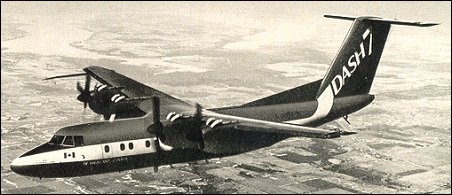 |
De Havilland Canada DHC-7 Dash 71975 |  |
| PASSENGER | Virtual Aircraft Museum / Canada / De Havilland Canada |
 |
The undoubted sales success of the Twin Otter led de Havilland Canada to initiate market research to estimate the interest in a large STOL aircraft which would incorporate the rugged reliability . that had become associated with the products of the company. The intention was to develop a small airliner with advanced STOL capability, so that higher standards of comfort, comparable with much larger aircraft, would be available to those airlines which operate from runways about 915m in length. The necessary interest was forthcom- ing, and with backing from the Canadian government the, construction of two pre-production de Havilland Canada DHC-7 aircraft began in late 1972, the first of these making its initial flight on 27 March 1975. Of high-wing monoplane configuration, the DHC-7, which is named Dash 7, derives its essential STOL capability from wide-span double-slotted trailing-edge flaps that operate within the slipstream of the slow-turning propellers of the four wing-mounted turboprop engines. In addition, there are four spoilers in the upper surface of each wing. The inboard pair serve as spoilers or lift dumpers, the outboard pair as air spoilers which can also be operated differentially in conjunction with the ailerons to augment lateral control. The fuselage is of fail-safe construction to permit pressurisation, and a very high T-tail places the tailplane and elevator well clear of the propeller slipstream. The landing gear is of the retractable tricycle type, with twin wheels on each unit, and the powerplant consists of four Pratt & Whitney Aircraft of Canada PT6A-50 turboprop engines. To reduce noise levels to a minimum, each drives a large-diameter 3.42m, slow-turning propeller. Accommodation is provided for 50 passengers, with access to the main cabin via a single door, incorporating air-stairs, at the rear of the cabin on the port side. There are provisions for optional mixed passenger/cargo or all-cargo operations, and a large freight door can be installed at the forward end of the cabin on the port side. In passenger service there is ample room within the cabin for a galley, toilet facilities, and one or two flight attendants. The flight crew of two is accommodated on a separate flight deck, and advanced avionics to enhance their efficiency include an autopilot/flight director system which incorporates flight and air data computers, and weather radar. The first operator to receive the Dash 7 was Rocky Mountain Airways, on 3 February 1978. When production finished in December 1988 113 had been delivered to 35 customers in 22 countries. Military use of the Dash 7 was restricted to two used as VIP/transports (designated CC-132) by the Canadian Armed Forces in Germany from August 1979 to April 1987, and a single aircraft delivered to the Venezuelan Navy in May 1982 used in the patrol and transport roles. VARIANTS Dash 7 Series 100: standard passenger version seating 50 passengers. Dash 7 Series 101: all-cargo version of Series 100 able to accommodate five standard pallets. Dash 7 Series 150: developed passenger version introduced in 1978 with higher gross weight, increased fuel capacity and improved passenger amenities. Dash 7 Series 151: all-cargo version of Series 150. Dash 7 IR: single special ice reconnaissance version of the Series 150 built for the Canadian government. Equipped with SLAR and computers to track ice formations and flow patterns, the aircraft was delivered in May 1986 and is operated by Bradley Air Services for the Department of Environment.
|  COMPANY PROFILE | ||||||||||||||||||||||||||||||||||||||||||||||||||||||||||||
 |

|

